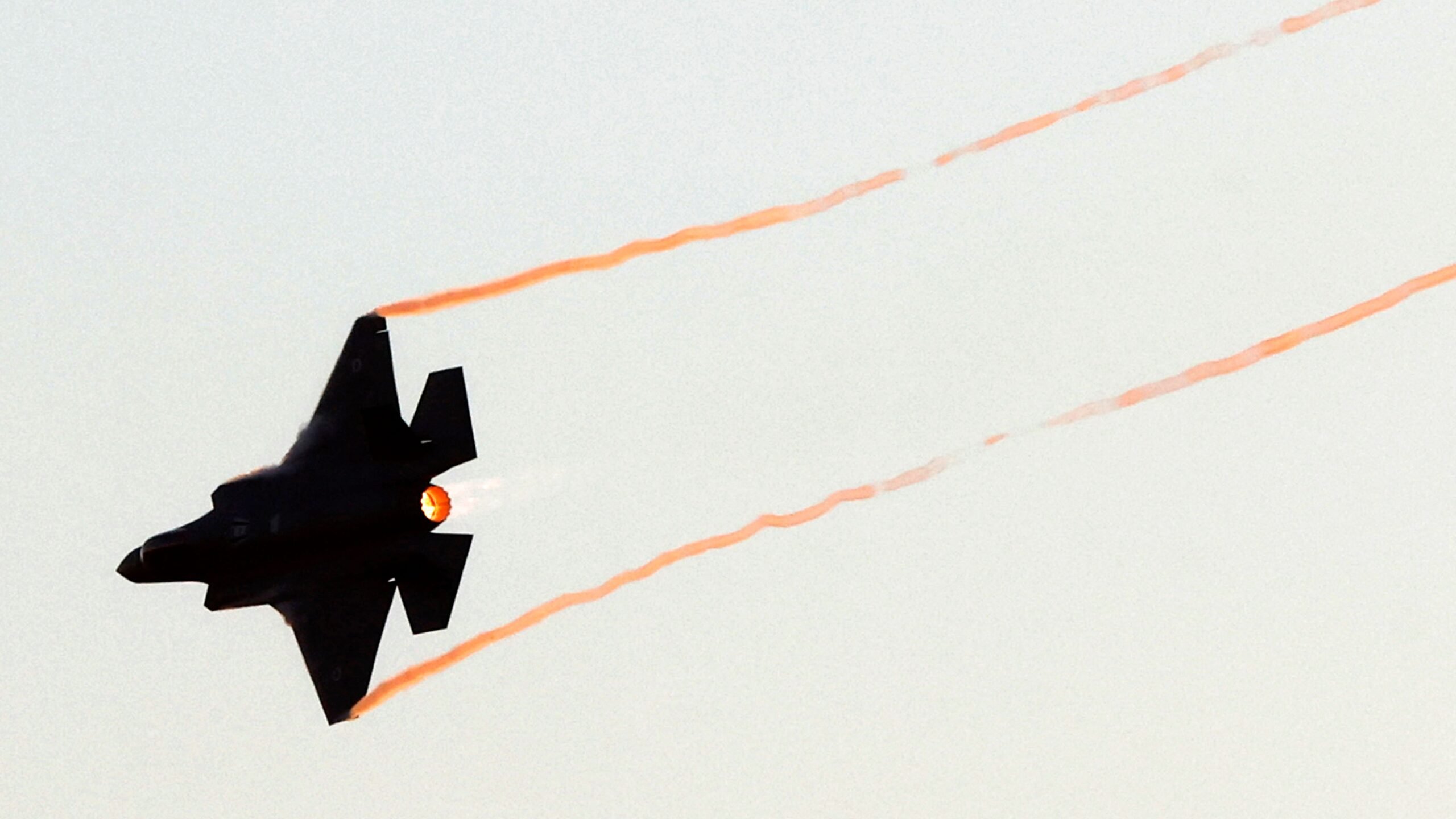
An Israeli Air Force F-35 Lightning II fighter jet performs during a graduation ceremony of Israeli Air Force pilots at the Hatzerim base in the Negev desert, near the southern city of Beer Sheva, on June 24, 2021. (JACK GUEZ/AFP via Getty Images)
TEL AVIV: The first Iranian UAV was detected by Israeli sensors at 1:50 am on March 13, 2021, approaching Israel from the south. The second UAV was detected at 2:12 am, approaching Israel from the east. Minutes later, both Iranian-launched drones were shot down by Israeli Air Force (IAF) F-35s, the first acknowledged operational air-to-air kill for the fifth-generation fighter.
Operation Two Bridges, as the F-35 strike was known, happened almost a full year ago, but the details were uncovered only today during a special briefing by the IAF. The timing is noteworthy: Israel is making public the information as a deal to revive the 2015 Iranian nuclear agreement, which Israel opposes, appears close to completion.
Vitally, Israeli sources say the operation led to the formation of a recently announced “Anti-UAV coalition” aimed at protecting Israel and some other countries from the growing threat of the Iranian made UAVs.
RELATED: Israel Wants To Put New Equipment Inside The F-35: Exclusive Q&A With Top Officer
The two Israeli high ranking officers, one from the IAF and the other from the Israeli Defense Forces (IDF) intelligence, told reporters that the two drones were Iranian made systems, the detection of which was made by a combination of an IAFAEW aircraft, and ground radars, the officers said.
These two systems were on a transport mission, believed to be part of a technical evaluation of the drone, which Israel briefers called the Shahad 197. After the two UAV’s were shot down with air-air missiles launched by the F-35, the remains were recovered and it was discovered the two systems were carrying hand guns, believed to be headed for Hezbollah in Lebanon and Hamas in Gaza, two Iranian proxies.
“The plan was to drop the cargo over Lebanon and Gaza and fly back,” one of the officers said.
The F-35s took off from Nevatim Airbase in southern Israel. One plane belongs to the 116 squadron and the second to the 140 squadron. The officers said that the radar and other sensors aboard the F-35 make the aircraft the ideal one for such missions. “We anticipated the threat and made some changes that improved the aircraft capabilities in this type of mission” one said, without elaboration.
Neither officers nor other sources would say exactly where the intercept occurred, other than to acknowledge it was outside of Israel’s borders. The two senior officers also refused to name the countries the Israeli F-35 had to cross to intercept the two Iranian UAVs, but the fact Israeli jets were able to safely travel in the region is a sign that at least some cooperation is happening between Israel and others on the Iran issue.
Making History:
Last year, Israeli "Adir" (F-35I) fighter jets successfully intercepted two Iranian UAVs launched towards Israeli territory. pic.twitter.com/FQsEjKzxct
— Israeli Air Force (@IAFsite) March 7, 2022
In addition to being notable for the first (or at least publicly known) air-to-air strike by an F-35, Operation Two Bridges helped push the creation of a recently formed “anti-Iranian drone” coalition.
The coalition is a fairly new organization that has agreed to work together to counter the threat from Iranian-made UAVs, which are increasingly seen as a primary tool for Iranian aggression in the region. Israeli official sources refused to comment on the structure of the coalition, including who is involved, but sources in Israel said that “US sensors in the relevant region are assisting the effort” and that the group is made up of “targets of Iranian aggression.” Given that, it seems safe to assume both Saudi Arabia and the UAE are involved.
The close intelligence sharing between the coalition members resulted last week with an attack on a command center in Yemen, from which coalition sources say Houthi rebels have conducted armed drone attacks on Saudi Arabia, the UAE and other targets in the Gulf region.
Meanwhile, there is growing evidence that Saudi Arabia is following Israel’s tactical lead and has begun attacking convoys of Iranian weapon inside Syria, in an attempt to destroy weapons bound for Houthi forces before they can arrive in Yemen.
Israel has already attacked Iranian bases hundreds of times throughout Syria as well as convoys of weapons making their way from Tehran to Syria and Lebanon through Iraqi soil, in an attempt to reduce the power of Iranians operating on Syrian soil.
According to an Israeli defense source, in recent months Iran’s Revolution Guard Corps (IRGC) has been increasing the delivery of drones to its proxies in the region and beyond. He noted that now Iranian-backed forces in Iraq, Syria, Yemen, as well as Hezbollah in Lebanon, have received these drones, adding that they were also sold to Venezuela.
Yemen’s Iran-backed Houthi movement said in November it had fired 14 drones at several Saudi cities, including at Saudi Aramco facilities in Jeddah.
The coalition will also benefit from the new naval version of the Israeli Iron Dome air defense system, known as the “C-Dome” system, which in late February successfully completed a series of live-fire tests. Israeli sources told Breaking Defense that the C-Dome will increase the protection of the Israel gas pumping rigs in the Mediterranean but will also detect threats “far away from Israel.”
Sullivan: Defense industry ‘still underestimating’ global need for munitions
National Security Advisor Jake Sullivan said that there are “no plans” for another Ukraine supplemental at this point.


























